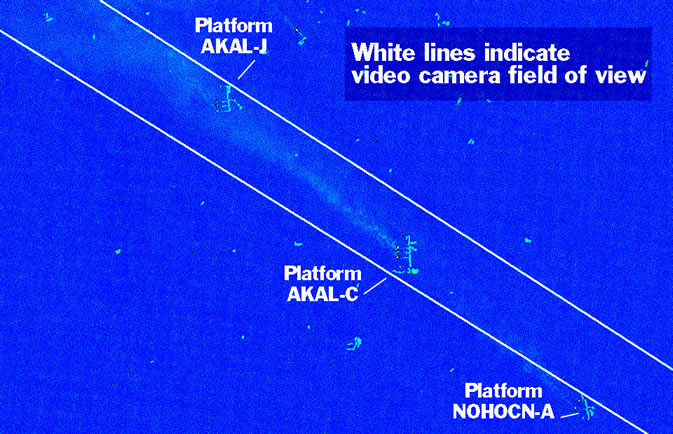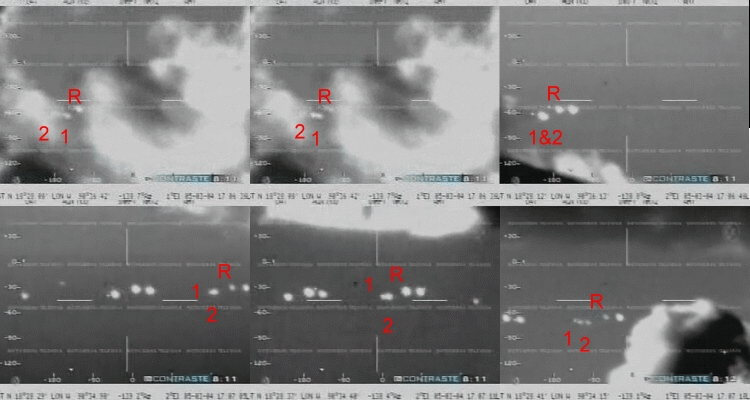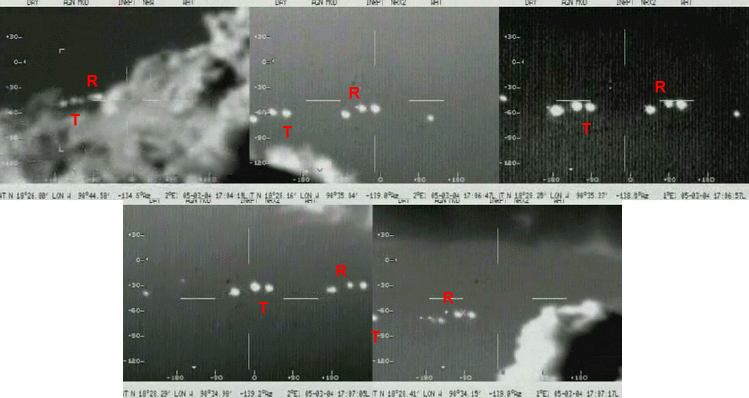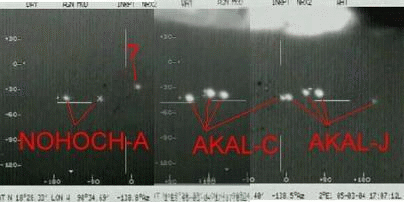

Oilwells responsible for the images in the video (Smith)
Oil wells don't move with respect to each other, do they?
by Tim Printy © August 2004
Updated January 2005
A few investigators noticed something peculiar on the videotape around the time 17:06:36-17:07:18. In this sequence of images, one can see how two of the objects merge and the separate. Some have implied that this is "mysterious" or "unexplainable". There is nothing unusal about this event.
In the image below, I have marked the two objects that merge and separate as "1" and "2".

Sequence showing the merging and the separating of two of the objects in the video. Frame grabs using "Snatch-it" and video taken from video located at Thomas Strunch's webpage http://www.pixcells.dk/mexico/mexicoDODstream.wmv
To better understand what might be occurring during this sequence, I marked the object to the upper right of these two, "R" for reference. I then measured the number of pixels of 1 and 2 in reference to "R".
| Time | Pixels R to 1 | Pixels R to 2 |
| 17:06:36 | 14 | 18 |
| 17:06:46 | 16* | 18 |
| 17:07:05 | 22 | 18 |
| 17:07:11 | 24 | 18 |
| 17:07:18 | 27 | 19 |
* This assumes that the elongation on the right of the blob is from object #1.
table 7 - angular motion for the "stray" light that merges and separates
While the use of "R" as the reference might not be precise, it does show a trend. What is happening is that object #1 is a foreground object and the others (R and 2) are more distant. As the plane is flying towards the east, object #1 is moving at a greater angular rate than "R" and "2". As a result, #1 appears to merge with #2 and then separate from it. Equally convincing is the fact that the angular rate over the entire 42 seconds equates to roughly 0.31 pixels/second, which is roughly maintained throughout the sequence.
This sequence also ties into what is happening with the two sets of three in the same video clip. I performed some frame grabs of the objects using "Snatch-it".

Frame grabs using "Snatch-it" and video taken from video located at Thomas Strunch's webpage http://www.pixcells.dk/mexico/mexicoDODstream.wmv
If you measure the pixel distance between "R" and the right most object in the second "trio" of lights "T", you will discover an interesting trend.
| Time | Pixels from "R" to "T" |
| 17:04:15 | 28 pixels# |
| 17:06:47 | 76 pixels |
| 17:06:57 | 79 pixels |
| 17:07:05 | 81 pixels |
| 17:07:17 | 84 pixels |
# The original value was about 14 pixels but this was in narrow mode. One has to double the value to match the scale of the other images.
table 8 - angular measurements for the motion of the second trio with respect to the first
In the 30 seconds between 17:06:47 and 17:07:17, the shift is 8 pixels, which equates to 0.27 pixels per second. This is not much different than the 0.31 pixels per second for the merging issue described. If one looks at the value from 17:04:15, we see a shift of 56 pixels in 182 seconds or 0.31 pixels per second. Considering the problems with measuring precisely the shift involved, it is apparent from the rate of motion involved with respect to "R" that the object #1 and the second trio are related.
When James Smith published his 3D models in E-Skeptic newsletter 28, I was suprised to see that the three oil wells, AKAL-C, AKAL-J, and NOHOCH-A were almost in line during the time period around 17:07. According to Smith's calculations, the objects in view are probably AKAL-C and AKAL-J. They are shown in some aerial shots as having 4 boom flares apiece. AKAL-C is probably the second trio of lights and the light I labeled "1" in the first sequence. The second trio of lights is AKAL-J, which is more distant by about three miles. As the aircraft flew towards the northeast, the view of the two oil well sites were initially almost in line with each other. As the plane flew more northeast, the angular rate for the closer of the two (AKAL-C) was greater because it was slightly closer and the sets of lights moved further apart.
Side note: In recent communications with me, James Smith mentioned that a key part of the investigation was him acquiring the Landsat images of the oil wells. This allowed him to perform his 3D models and positively identify the sources of the FLIR images. Investigators should have been appreciative of Smith's work in helping to resolve the issue. Instead, like Franz, his work was not worthy of any significant praise by UFO investigators in the UFO Updates forum.
The 0.3 pixels per second value converts to roughly 0.0005 degrees/second in the images I captured (176 pixels for 0.3 degrees vertical in narrow X2 mode). If one looks at the distances for AKAL-C and AKAL-J for 17:06:36 and 17:07:16 in my table 4, one can compute if this rate of change is the same as one might expect for an aircraft in these two positions. The azimuth with respect to north for these positions using a handy webpage are:
| AKAL-C | AKAL-J | NOHOCH-A | |
| 17:06:36 | 304.74 | 304.89 | 304.49 |
| 17:07:16 | 303.89 | 304.07 | 303.63 |
table 9 - computed angular rate for oil wells NOHOCH-A, AKAL-C, and AKAL-J using distances computed in table 4
The difference between the two is .00075 deg/sec, which appears very close to the values seen in the images above. Considering the resolution issue with the locations, this does not seem to be too significant an error.
As a final check, I checked the two lights to the left of the AKAL-C "trio". It was hard to find two images far enough apart but I did manage to find one at 17:06:26 and 17:07:07. These two lights were moving away from the AKAL-C trio at a rate of roughly 0.37 pixels (0.0006 degrees) per second. This is similar to the rate at which the AKAL-C "trio" was moving in relation to the AKAL-J "trio". The distance between the two horizontal lights is always about the same, which means they are the same platform. Looking at table 9, we see the rate of change appears to be about .00025 deg/sec. Again, considering the resolution issues, the values seem to be in the ballpark. These two lights are most likely NOHOCH-A.
There is one more light to the upper left of the second "trio". The AKAL-C trio is closing with this light at a slow rate of 0.06 pixels (0.0001 degrees) per second. This implies it may be part of AKAL-C and the measurements are off or the light is some source that is just beyond AKAL-C. Looking at this image of AKAL-C, one can see that there is an inactive boom, which appears to be a bit further back than the others. It is possible that this is the stray light visible in the video.
The image below shows identification of the lights with a "?" for the one light that may be part of AKAL-C.

The likely sources of the FLIR images around time 17:07
As a last check, I decided to see if the apparent angular size was what one would expect from the oil wells. One can scale the oil wells in the photograph posted by James Smith. The oil wells are roughly 3.11 miles apart based on the transponder longitudes and latitudes. Converting the number of pixels between the oil wells, I discovered the distances measured out to be just about right and the average scaling was about 69 feet/pixel. Measuring the pixels for the different flares, I determined that the width of the four flares on AKAL-C and AKAL-J were about 1725 feet apart. The width for the two flares on NOHOCH-A was 621 feet. When one computes the apparent angular size of these widths from the distances computed in table 4, we come up with some interesting values that can be compared with the image above:
| 17:06:36 | 17:07:16 | |
| AKAL-C calculated | 0.165 deg = 96.8 pixels | 0.162 deg = 95.0 pixels |
| AKAL-C measured | NA | 17:07:05 = 94 pixels |
| AKAL-J calculated | 0.161 deg = 94.5 pixels | 0.158 deg = 92.7 pixels |
| AKAL-J measured | NA | 17:06:57 = 88 pixels |
| NOHOCH-A Calculated | 0.061 deg = 35.8 pixels | 0.060 deg = 35.2 pixels |
| NOHOCH-A measured | NA | 17:07:07 = 34 pixels |
table 10 - Computed angular sizes for oil wells AKAL-C, AKAL-J and NOHOCH-A using distances computed in table 4 compared with actual measured values.
NOTE: I am aware that the following webpage has performed a similar analysis prior to my posting these calculations. I can only state that I did this work independent of theirs. However, I want to give them credit (as well as James Smith) for their work on this matter.
Considering that the distances and sizes are not completely accurate and that the oil wells were not seen from a 90-degree angle (making the apparent angular size smaller), the numbers are pretty close to what is calculated. When one couples the angular size, angular rate change, parallax calculations, and the bearings towards the oil wells, one can paint a pretty convincing picture that these oil wells were the source of the images in the video.
Recently, Dr. Bruce Maccabee presented his argument against the oil well theory. His document, "A study of the March 5, 2004 Radar and FLIR sightings during a surveillance flight by the Mexican Department of Defense", is available for download and was completed in late 2004. After 103 pages of extensive analysis, Dr. Maccabee finally gets to his argument against the oil well flares being the explanation. In just seven pages he makes a case against the oil well flares being the source of the images. Initially, he agrees that the camera was pointed in the direction of the oil well field but this is where he ignores the rest of the arguments made by others in support of this theory. He does not even attempt to address the works done by James Smith and Captain Franz.
Dr. Maccabee's apparent problem with the oil well theory has to do with some of his angular measurements not agreeing with what would be expected for oil well flames. Since the work I presented here seemed to paint a pretty convincing picture, I was curious what angular measurements did not compare closely with what can be predicted. His first measurement has to do with the angular separation between each of the lights in the video not matching his calculated values. In order to correctly measure the angular distances between oil well flames, one must at least make an effort to understand what one is measuring. Dr. Maccabee apparently did not research this very well. Had he made a cursory examination of the Landsat image acquired by James Smith, he never would have written section A4.7 and A4.8 as he did. In a gross inaccuracy, Dr. Maccabee tries to make one think that each oil well platform consisted of only one flame. He clearly states in section A4.7 that his calculation "... rules out the combination of these three platforms as the source of one (my emphasis) triplet" (Maccabee A study). The three platforms he is referring to are AKAL-J, AKAL-C, and NOHOCH-A. As one can see from the article by James Smith, each platform has multiple flares. Both the AKAL platforms have at least four (and there may be a fifth for AKAL-C based on this picture) and NOHOCH-A has two. As noted in my diagram above, each "triplet" is actually part of one oil well platform!
When one examines my image, "The likely sources of the FLIR images around time 17:07", above, one can perform these calculations correctly. Using the right most light as a reference, I calculated the angular distance between AKAL-C and AKAL-J as to being roughly 0.15 degrees. Using the same methodology, I calculated the angular distance between AKAL-C and NOHOCH-A as being roughly 0.31 degrees. Dr. Maccabee predicted these values to be 0.16 and 0.25 degrees respectively. These values agree enough to be considered a reasonable match.
Dr. Maccabee's other angular measurement is somewhat of a stretch because it involves measuring extremely small values with undefined variables. According to Dr. Maccabee, if one of the triplets is from the oil well fires on platforms AKAL-J, AKAL-C, and NOHOCH-A, one should expect to see AKAL-J higher than AKAL-C and AKAL-C higher than NOHOCH-A. Once again, Dr. Maccabee's use of a single triplet to conduct his measurement is grossly inaccurate and completely invalid. Once again, I made some rough measurements of my own. However, I used the fourth frame in my image "Sequence showing the merging and the separating of two of the objects in the video" foundat the top of this page to make the measurement. If one examines the left light of each triplet and the leading light of NOHOCH-A, one can see that AKAL-J is 1-2 pixels greater than AKAL-C and AKAL-C is 1-2 pixels greater than NOHOCH-A. This computes to a value of about 0.0016-0.0032 degrees. Dr. Maccabee predicts 0.0039 degrees and 0.0053 degrees for these measurements. The AKAL-C and AKAL-J measurements are pretty close and considering the size of the frame I am using, within the margin of error. The NOHOCH-A is a bit off and may be due to several issues. The most obvious being the size of the image I am using. 0.0053 degrees would be 3-4 pixels difference, which is 1-2 pixels greater than what I measured. Another key variable may have to do with the heights of the flare towers being different. Both of these seems to be a reasonable explanation as to why the measurements are a not exactly as expected.
These measurements again present a convincing case for the oil well theory. However, Dr. Maccabee arrives at different conclusion based on his inaccurate assumptions:
From the calculations presented above it seems that at least some of the predictions of this hypothesis do not seem to agree completely with the flir image data. In principle it should be possible to establish a 1:1 relationship between gas flames and flir images. The fact that the calculations above do not seem to show agreement with the oil platforms that were chosen for this mathematical/geometric exercise could simply mean that I chose the wrong platforms to calculate. (Maccabee A study)
It was not a matter of selecting the wrong platforms but misidentifying how many lights were on each platform. Apparently. Dr. Maccabee did not have the time to waste to figure this out or talk to others, who might have that information. When James Smith brought this up in the UFO updates forum, he responded:
I know that there are gas flames in the direction the FLIR was looking and I know that each platform can have several flares. However,I also know that it isn't sufficient to say that there were gas flames in the direction they were looking and that proves all the light were gas flames. What would be sufficient would be to match up exactly more than half of the FLIR lights with specific flames... After I spent hours trying to locate a "perfect" match I essentially "threw up my hands in despair" because I knew I shouldn't have to be doing this" (Maccabee Re: Maccabee's).
It did not take any great rocket science by James Smith, Captain Franz, Andres Duarte, or myself to align the flares in the satellite image with the images on the video. Maccabee's despair seemed more a case of lacking a desire to investigate the matter or ask James Smith for the appropriate information. He WAS in contact with James Smith as noted in his paper but this, apparently, did not involve asking how Smith performed his 3D model which DID match the FLIR lights with oil well flames. Smith even puts the longitude and latitude of each flare he computed from the LandSat image on his webpage. Even when James Smith publicly listed the locations of the oil well flares on UFO Updates, Dr. Maccabee did not publicly respond. Instead of crediting Smith or attempting to duplicate the work, Dr. Maccabee decided to use an inadequate method that did not account for more than one flare per platform. As a result, his principle arguments in sections A4.7 and A4.8 are completely inaccurate and demonstrate a desire not to perform an objective analysis of, what he calls, a Candidate Explanatory Hypotheses (CEH).
Despite the best efforts of several UFOlogists to make this case appear to be something extraordinary, everything mentioned so far points towards one of three possibilities:
Considering these possibilities, it seems that the oil well fires is a likely explanation.
Works Cited
Maccabee, Bruce. A study of the March 5, 2004 Radar and FLIR sightings during a surveillance flight by the Mexican Department of Defense. 27 December 2004. Available WWW: http://brumac.8k.com/MexicanDOD5mar04/
-. "Re: Maccabee's Mexican Airforce Radar/FLIR UFO" 5 January 2005.UFO Updates Mailing list. On line posting. Available WWW: http://www.virtuallystrange.net/ufo/updates/2005/jan/m06-003.shtml
Smith, James . The Mexican Air Force UFO Affair: Aliens, Ball Lightning, or Flares? E-skeptic newsletter July 24, 2004. Available WWW: http://www.skeptic.com/eskeptic/04-07-24.html
NEXT: Radar contacts
Back to My skeptical opinion about UFOs